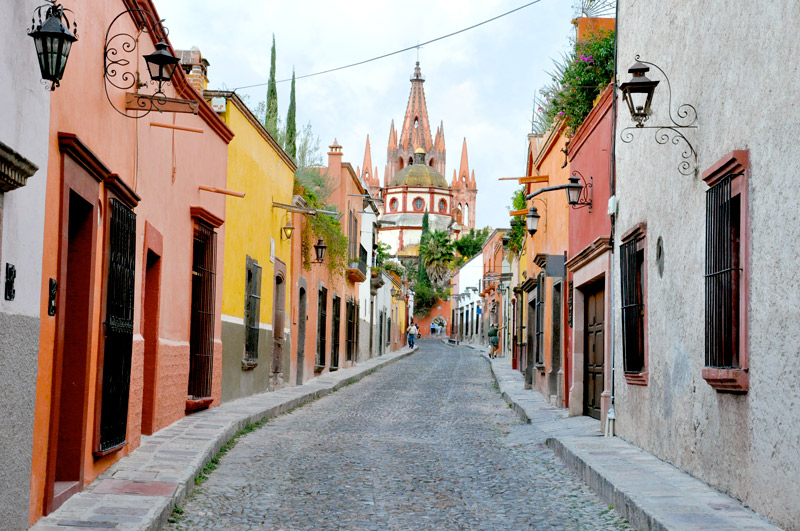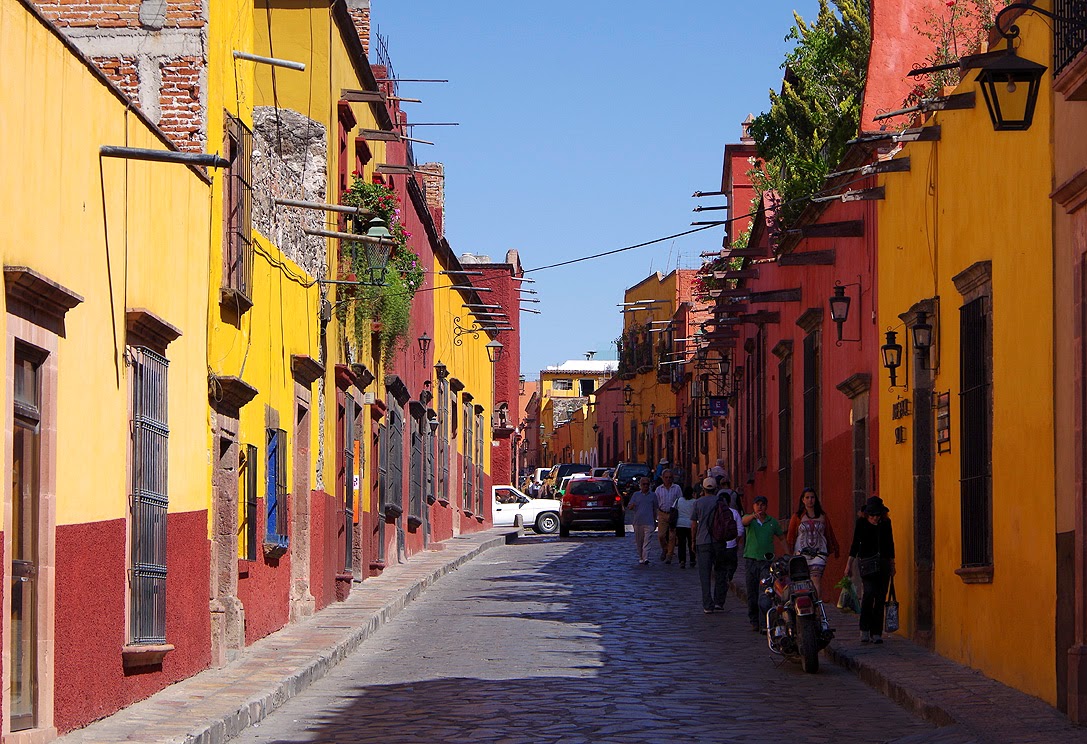The popular song lyric about the street with no name wasn’t written with San Miguel de Allende in mind. Our streets all have names, often several, that combined with a Dr. Seus like nonsensical numbering system even the Cat in the Hat would admire, causes endless confusion.
The neighborhoods were first organized by the Spanish. “Centro” was for the Spanish with the four oldest areas (barrios) set aside for the indigenous in “La Palmita“, “Ojo de Agua“, “Valle del Maíz” and “Guadiana“.

Street signs in San Miguel de Allende, Mexico. San Miguel de Allende is a UNESCO World Heritage Site.
“Colonias” are the areas a bit farther afield from the “jardín“, such as “San Antonio” (the largest neighborhood), “Guadalupe” (named for the wife of the owner of the factory that is now an art gallery), and others.
The word “fraccionamiento” is used for a planned development while enfondant implies an area of similar looking houses built at the same time and assigned to owners as part of the Mexican mortgage system. Assuming you’ve steady work, and are under a certain age (normally 35 so you live long enough to pay off your mortgage), you qualify to buy one of these low cost houses over a 20 or 30 year loan.
Why I mention all this is because neighborhood names repeat themselves and if you want a taxi to take you enfondant “La Luz” it is a different place than “fraccionamiento La Luz” and so on. If you blithely say to the driver “La Luz“, it’s anyone’s guess where you’ll end up!
On to street names….
The Spanish, given their obsession with the local mines and converting the locals, named the streets after Jesus, Mary, the saints and related religious notions like the Immaculate Conception or the Ten Commandments. Many of these streets were renamed after the revolution from Spain for the local founding fathers like “Aldama”, “Allende” and “Hidalgo“. (Look at the actual street signs to see what the street was called before in small print under the current name. Ignore the misspellings and odd use of abbreviations.)
Farther afield from the jardin geographic names popped up for the surrounding orchards and their corresponding plant life.
Recent subdivisions tend to focus on themes. “Colonia Guadalupe” prefers artists and songs while “Colonia Olimpo” leans towards Greek gods and goddesses. Often streets change name every block or so to simply keep you on your toes! Best of luck streetwalking on “Chorro/Barranca/Murillo/Nuñez/Calzada de la Presa” as they are all the same street. And, yes, street names are repeated around town with “Allende”, “Soledad”, “San Juan” and “Guadalupe” being oft-repeated favorites.
Calle means street and a “callejon” is an alley. A “cuesta” is a hill or slope. A “calzada” implies a paved highway though I’d question that logic given our use of cobblestones. “Libramiento” is a freeway while round-abouts are glorietas.
Some street names are logical if you know where you are. “Huertas” is for the orchards that once surrounded San Miguel while “Muertos” (Street of the Dead) leads down to the St. John of God cemetery. “Animas” is for all the Lost Souls that roamed the streets as ghosts following their recent executions in “Plaza Cívica”. “Chorro” is for the spring where the town was founded. “Calvario” is for Calvary, the hill Jesus died on and why his partner in death, St. Dimas, is named for the street that intersects it.
“Canal”, “Sollano”, “Hernández”, “Macías” and “Homobono” are named for important people and families. Meanwhile important dates like “5 de Mayo” for getting the French out of Mexico, “15 de Septiembre” for when the Revolution against Spain started and “20 de Enero” for my mother’s birthday (well, and Allende’s also) are the names of important streets.
One of the most touching street names has to be “Indio Triste” for sad Indian. Named for the indigenous lad that played sad music daily for his wife suffering in the indigenous hospital then behind the St. John of God Church. The musician felt his music would be carried by the angels to his ill wife and make her well again. I can only assume it did the trick and his spousal devotion won’t be forgotten if only for the unusual street name!
Joseph Toone is the Historical Society’s short-story award winning author of the SMA Secrets book series. All books in the series are Amazon bestsellers in Mexican Travel and Holidays. Toone is SMA’s expert and TripAdvisor’s top ranked historical tour guide telling the stories behind what we do in today’s SMA. Visit HistoryAndCultureWalkin






